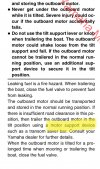Spoiledrotten
Well-Known Member
Good info. I did check my tire/wheel size yesterday. They are 13" rims with 175/80R13 tires.
Follow along with the video below to see how to install our site as a web app on your home screen.
Note: This feature may not be available in some browsers.
I understand the motomate is a hydraulic saver, not a transom saver which requires moving the weight of the motor to the trailer when trimmed up. YouTube has a great video on this detail.Here's an old post about asking the horse...
RolandAdmiral
- LocationShreveport, Louisiana
Posted 06 September 2012 - 04:01 AM
Hi guys... well between this forum and one other I frequent, I pretty much got a mixed bag of answers with regard we should use a transom saver when towing our bennys... so I decided to go right to the horses mouth.. sent an email to Bennington and asked them what the companys stance on this was.... got the reply today, they DO recommend the use of transom savers.... I started out to just get an old fashion TS that connects the trailers cross member to the lower unit... but then started reading all this stuff about " trailer shock " where hitting bumps, potholes, actually may damage the gears in the lower unit.. then I looked into the "wedge" devices, like " m-ywedge.com ". But I think the best one I've seen on the market is called motor mate. It has a bracket that actually bolts to the bottom of the lower unit... then the motor mate clips into that with two extension arms that attach to the lower unit. From what I've seen it not only supports the motor, but it also holds rock solid so that it can't tilt from side to side.... only problem is so far on their web site, the smallest yamaha motor there product will fit in a 4 stroke is a 115... I've got a 75. for those of you interested you can check it out at motormate.com At the top of the screen is a tab for youtube videos... It's a bit expensive, I think around $110 or so... If they don't make one that fits a 75, think I'll go with the wedge that fits over the cylinder rod that raises the motor... Weekends almost here, supposed to be in the low to mid 80's this weekend... screw the lawn, I'm going fishing!!!! before I go, in some or your responses, you said you lowered your motors till the "tabs" caught. Can you explain to me what those are.. I've always just trimmed my motor until it was all the way down when towing.
Roland
An very informative presentation:I understand the motomate is a hydraulic saver, not a transom saver which requires moving the weight of the motor to the trailer when trimmed up. YouTube has a great video on this detail.
I see what the difference is now. 40 years ago I was using the rubber block. I’ve never seen a transom break or crack have damage. I’ve seen hydraulic leaks and issue with tilt and trim. Have the boats changed that it’s necessary to use one? Also on the pontoon the lower unit isn’t as close to ground as maybe a bass or v hull boats. Is it really necessary??An very informative presentation:
I've read quite a bit of the arguments on this topic and here's my take. Engine manufacturers like Yamaha recommend a "motor support device" if they can't be trailered in the full down position, which people interpret as protection for the transom. I believe Yamaha and Mercury could care less about the transom, that's the boat mfr's issue if it can't take stresses from bouncing down the road. I believe the engine OEM's want to protect against their trim/tilt mechanisms failing and having the lower unit drag on pavement creating a warranty claim. Hence them specifically using the term "motor support device".I see what the difference is now. 40 years ago I was using the rubber block. I’ve never seen a transom break or crack have damage. I’ve seen hydraulic leaks and issue with tilt and trim. Have the boats changed that it’s necessary to use one? Also on the pontoon the lower unit isn’t as close to ground as maybe a bass or v hull boats. Is it really necessary??
Thanks

I see what the difference is now. 40 years ago I was using the rubber block. I’ve never seen a transom break or crack have damage. I’ve seen hydraulic leaks and issue with tilt and trim. Have the boats changed that it’s necessary to use one? Also on the pontoon the lower unit isn’t as close to ground as maybe a bass or v hull boats. Is it really necessary??
Thanks